It’s been a good month for traveling to new places. A year ago if I’d written that here, it would meant that I was biking, hiking, or jetting off to new exotic lands where they put a lot of cumin on the falafel (like the Palestinians in Nazareth). This year it means two separate trips down to the American South, first to Virginia at the beginning of the month, and just this past weekend to Alabama.
For anyone who’s read my blog for awhile, my Iraqi translator in Jordan, Wamidh, will be a familiar name. He was successfully relocated to America with his wife Hanan in early 2011 and my parents and I were looking forward to taking a trip to meet them – and to enjoy the warmer “southern” weather after surviving yet another Wisconsin winter. In my case, after so many months spent in the always-balmy Jordan, this winter seemed particularly unfriendly – although I’m sure it was just me.
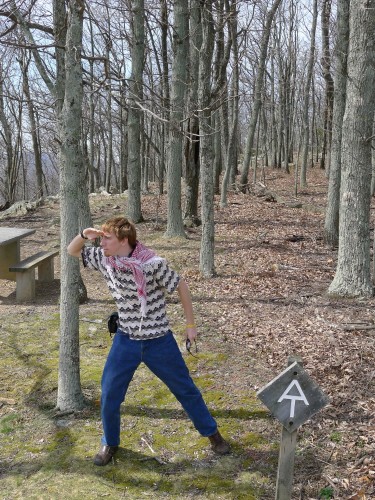
Between visits, I took my first steps onto a tiny segment of the famous Appalachian Trail - sometime I'll do the whole thing!
I can only hope that everyone in the world can someday get a chance to experience real Arab hospitality. Although neither of my parents and certainly myself are strangers to it, it was humbling to once again be treated with such absolute kindness and friendliness that you can only get from Eastern cultures. We had brought some Amish Friendship Bread along too, and after we explained what “Amish” meant to the two Iraqis, they were overjoyed to be able to add it to their piles of sweets that they already had been planning to serve us.
Eating can become an all-day affair when confronted with an Arab banquet meal like the ones Hanan had prepared for us. A trip from our hotel to their apartment on our first night, which had been intended just for some coffee, turned into a 4 hour gathering with a beaming Hanan bringing us four or five platters of sweets and drinks out of the kitchen for us. My parents and I were happy to see that they were settling in well in their new country, and Hanan’s English was coming along quite well. In fact, I had to mentally stop myself from speaking in Arabic to the two of them several times throughout our visits, reminding myself that I was no longer a stranger on their side of the world, but it was the other way around and I needed to be helping them gain more and more experience and immersion in the peculiar American way of speaking.
Wamidh had to chuckle as he told us of his experiences understanding the “southern” accent. Throughout his work with EGT and his hundreds of hours working with me as my translator, he’d become used to a midwestern dialect, or an east coast accent like what some of our other coworkers had. The drawl or twang of Virginians was like starting over again, and he admitted having to ask several people to repeat themselves when he first arrived.
I was interested to notice that Hanan no longer wore her hijab hair covering anymore, something which I had been telling my parents before we arrived I was sure wasn’t going to change. When I commented on it, and being able to see her hair, she told me with quiet determination that she wanted Americans to feel comfortable around her and want to talk with her, and learn more about her. Someday I might wear the hijab again, she told me. But first, I want others to learn about the “real Hanan.” She felt – probably with good reason – that other women in the neighborhood might be shy or unlikely to engage her in conversation if she was dressed in more stereotypical Muslim women garb, and she was willing and determined to not let that happen by being proactive with a large personal and religious choice like this.
For our final dinner with our friends, Hanan pulled out all the stops and made a meal so large that it took us almost 7 straight hours of eating and chatting to work our way through all the courses she had made. She sat across the table from my mother and jokingly wagged her finger at all of us if we ever paused for longer than a minute in our quest to reach the bottom of our bowls. “Eat…you need to be eating more!” she would cluck at us. We asked Wamidh how on earth he ever managed to ever leave the table while married to such a dynamic chef. “I don’t give her a chance to refill my plate when I’m finished!” he exclaimed with a serene smile. “I just grab my plate and run to put it in the sink before she can!” By the time we left, filled with food and delicious Turkish coffee, my mother commented that we could probably be rolled up the interstate back to Wisconsin like little barrels. I don’t think I’ve ever felt so full in my life.
Besides our visits, we had time for a few other things while in Roanoke. The city had a thriving little farmer’s market on Saturday morning, similar in style to Madison’s, and we bought some local pottery, baked goods, and heard some local lore. I can’t speak for my parents, but like Wamidh, I found myself wishing that I had a small box that would generate small subtitles to help me understand what the old Virginian farmers were saying.
We drove up to Roanoke’s Mill Mountain to see the local treasure, a huge metal frame star that was built several decades ago to commemorate the city’s nickname, the “Star City of the South.” The views of the surrounding mountains north of the city were impressive on the clear Sunday morning, and we could see little plumes of stone being thrown high into the air many miles away, in what must have been some West Virginian coal mines. There’s a website that utilizes a small camera that they mounted on the star; it takes a little low-res snapshot every 15 seconds of the observation deck below.
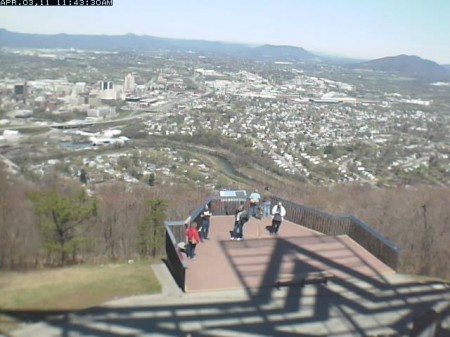
In order to prove that we were indeed there! (I'm looking at the starcam website on my phone, as my parents watch me)
I think our favorite non-Arab part of our trip was visiting the Mill Mountain Zoo, another attraction only a few hundred meters away from the star. The little zoo was affordably priced and had a good selection of animals to view, and a well-trained staff of young keepers that all looked around college age and had a friendly relationship with their four-legged charges, many of whom would literally do a happy dance of joy at the sight of the staff’s green polo shirts. Although it would have been easy to see the entire park from end to end in less than hour, we stayed closer to 3, chatting with the keepers and watching the animals get fed.
A mere couple weeks later, I joined the Wisconsin 4-H Extension office as a chaperone on my first visit to NASA’s Space Camp in Huntsville, Alabama. I have dozens of fond memories from my own childhood in 4-H. I’ve done everything from small county-level trips to Chicago and around northern Wisconsin, to state-authorized trips to Washington D.C. and New York. As far as I know, the Space Camp trip must have been added sometime after I had already graduated from the organization, otherwise I surely would have gone.
Although my only other chaperoning experience was several years ago for the 4-H show choir in Milwaukee, I enjoyed it and thought a shorter, but much more distant trip might be a lot of fun. Interestingly enough, several other chaperones had even been chaperones on my own childhood trips, which they enjoyed pointing out to my young charges.
My group, “Casper” – so named after the Apollo 14 command module – was led by a big friendly guy from Florida named Mark, or “Ox” as he was known by the Space Camp group. We had a fun three days wandering around the museums and exhibits of the Space Camp grounds, building our own model rockets – something which might be completely new and exciting to other groups of kids, but I was proud when in response to Ox’s question of ‘has anyone built a model rocket before?’ all but one hand went up into the air. 4-Her’s are smart kids!
One of the first things we did was get divided into our “mission roles” – probably one of the most famous parts of Space Camp, made so by the 1986 movie of the same name. Although we didn’t get blasted up into space by an insane anthropomorphic robot, we were divided into three teams – one for Mission Control, one for the space station, and one for the shuttle control team. Although my team of mission control kids didn’t get the cool orange (and poorly-fitting) jumpsuits like the other two groups did, we did get to stare at computer screens a lot! Almost like real life for one person on their team…
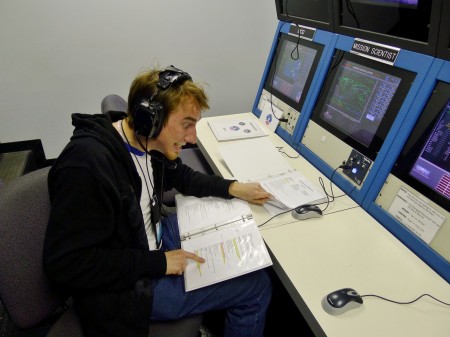
There weren't enough kids for a full team, so Ox had me playing both the Mission Scientist and the Propulsion Officer at the same time: having two scripts to have to pay close attention to was tough!
Besides the full size exhibits of historical rockets and engines, there were the rides, which of course I think the kids might have enjoyed even more. Everyone had heard of the moon jump, which simulates the 1/6th gravity conditions of the moon, and the space shot, and the G-Force, but then there was also the Multi Axis Spinner, which was created solely to screw with astronauts as kind of an engineer’s prank at NASA.
Okay, fine, its original purpose was to help train Apollo astronauts what to do in case their command modules started to uncontrollably spin about during the re-entry into Earth’s atmosphere. Since those old-style command modules only had their incredibly heat resistive layers on one side, and required precise angular placement, astronauts in one of these uncontrolled spins would have had only minutes to figure out how to right themselves again. We were dealing with a “modified” one, obviously – an actual trainer would have also had a control stick in front of me, and I would have been placed into it with the purpose of seeing how long it took me to stop the rotations. We were told that Apollo astronauts were put into this thing for hours at a time to make sure they were completely immune to sickness caused by the violent movements. Sounds like fun, doesn’t it?
I was very pleased with how well behaved both the small group of kids in my Casper group were, and the boys in our large, barracks-style sleeping room both were. Although I never worried about not enjoying the trip and my time as a chaperone, I came in expecting to have to be shushing kids all the time, especially when it was supposed to be sleeping time (the Space Camp administrators and Ox enforced strict rules for all attendees; kids were sent to bed at 9:30 and roused at 6:30 or so, without exception) but I was pleased to be wrong. Either the kids were just really well behaved, or exhausted each night, or they were secretly using electronic games under their sleeping bags – a problem that didn’t exist back when when I went to 4-H camp in the Wisconsin Dells area! (Game Boys existed, but they certainly didn’t have any sort of backlight on them).
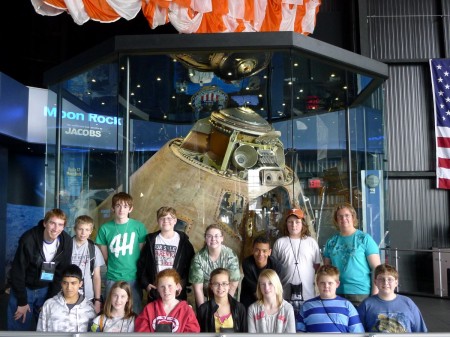
I had a lot of fun on both trips, and I can’t wait to see both Wamidh and Hanan and Space Camp again sometime soon, I hope!
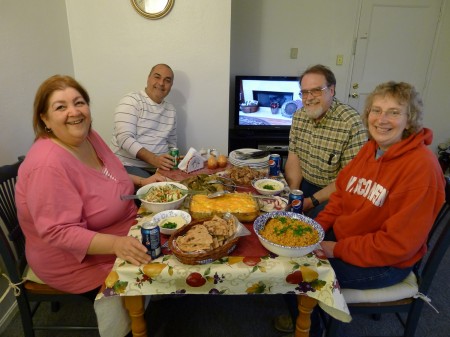


You are a fine traveling companion, and as always, your company was greatly appreciated on the Roanoke trip. I look back fondly on our family vacations with you and/or Josh, and hope we have a few more yet to come. Wamidh & Hanan were every bit the generous hosts that you describe, and we really enjoyed our visits with them!
It was great to hear and read of your experience at Space Camp, as I’d always thought it seemed like a cool place to visit. I hope you get to do that through-hike of the Appalachian Trail someday, and I look forward to hearing your account of it, which may rival Bill Bryson’s!